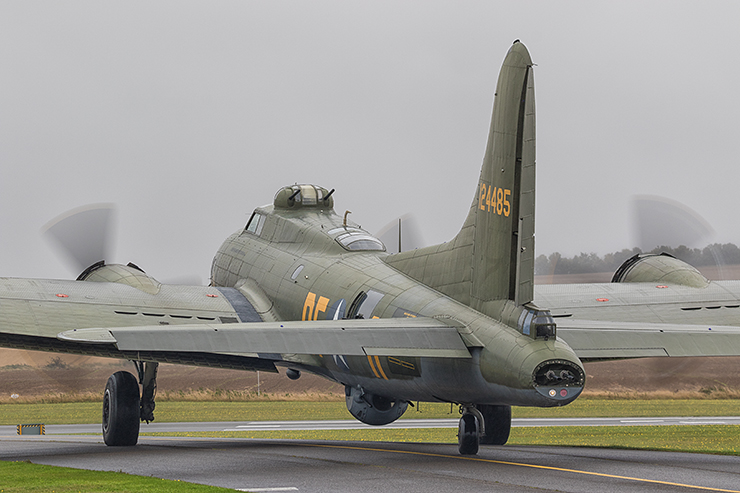| Duxford
Meet the Fighters 2016
|
 |
|||
| "...the flying that did take place was sandwiched in between rain, wind and a low cloud base" September heralds the final foray in the air show calendar at IWM Duxford, with this years show dedicated the development of fighter aircraft through the decades. 2016 celebrates not only the 80th anniversary of the formation of RAF Fighter Command, but also the 80th anniversary of the first flight of RJ Mitchell’s Supermarine Spitfire. Spitfire Prototype K5054 took off from Eastleigh Aerodrome on the 5th March 1936, making history with what was to develop into one of the most famous fighter aircraft of the Second World War; the first of just over 20,000 further airframes of various marks throughout its 19 year active service life.
This Septembers show held a lot of promise with a line up including
World War One era aircraft, a varied selection of World War
Two era fighters and a trio of early Cold War jet airframes
from the Norwegian Airforce Historic Squadron. The star of the
show was undoubtedly a planned massed spitfire display consisting
of 14 of Supermarine’s finest. |
|||
|
|
|
||
The weekend at IWM Duxford saw polarising extremes in weather, with Saturday being the gloomiest and wettest weather I have ever attended an air show in, and Sunday being blessed in fantastic sunshine and light. Sadly….. I was only in attendance on the Saturday. Unfortunately that is how it goes. The flying programme which has been carefully planned and programmed by the teams behind the scenes had to be abandoned, and the flying that did take place was sandwiched in between rain, wind and a low cloud base which offered low levels of visibility. The
flying kicked off on time with a brief pairs display from the
Hawker Fury II of Air Leasing and Grumman F8F Bearcat of The
Fighter Collection. The flying from Richard Grace and Pete Kynsey,
although brief was still a lovely sight, and sound. The two
large radial engined aircraft displayed the pinnacle of piston
power; designs soon overtaken by the birth of the Jet Age. The
pair performed two close formation flypasts before returning
to the ground to escape the weather. |
|||
|
|
|
||
|
It was at this point the flying programme underwent some changes with the next two acts scrapped due to the appalling weather conditions. The Great War Team in their WW1 reproduction aircraft never got chance to leave the safe confines of the hangars and the Avro Lancaster of the BBMF was unable to reach Duxford due to weather fronts on route. A quick rearrangement and it was the turn of the Global Stars in their Extra 330SC & Extra 260 aircraft to perform to the patiently waiting crowds. The team taxied out and held, awaiting a brief break in the weather. Once airborne the clutch of small aerobatic aircraft performed admirably in such poor conditions, showing off some great formation work and head on passes. The programme came back inline with the next act being the 109 Pair (depicted by Hispano Buchons), flying a fantastic duo display with some close formation flying and dives along the flight line. Whenever I see this pair display they seem to get better and better and tighter and tighter in their formations. A great site, the only shame being the weather. |
|||
|
|
|
||
The Desert schemed Buchon came into land giving way to two Spitfire’s getting up into the air for the next segment of this display; Dunkirk. A tail chase soon ensued between the allied and axis powers, with the RAF’s airframes victorious as the Dunkirk camouflaged “109” turned on the smoke to depict the aerial “kill”. A regular tail chase scenario often seen at Duxford, which is one of the things that makes these air shows special. One thing that did sit a little peculiar with me was the use of a Mk V airframe in the sequence, considering there were three other Mk Ia’s sitting on the flight line. The weather prompted a break in the flying before the Gloster Gladiator Mk II of The Fighter Collection performed an entertaining display up and down the length of the flight line, showing the manoeuvrability of the 1930’s bi-plane fighter. Next up was the trainer segment of the flying programme consisting of a North American Harvard IV of the Aircraft Restoration Company, along with a pair of de Havilland DHC-1 Chipmunks, all wearing a similar silver paint scheme. The trio performed a number of formation passes and a small amount of individual flying before returning to land. |
|||
|
|
|
||
Following on as per planned flying schedule it was time for an individual display from Mark Jeffries of the Global Stars in his Extra 330SC. Admittedly a great display of aerobatic flying, but there was the air of Déjà vu after the earlier display from the whole Global Stars. The Cold War Era brought a lovely warmth to those on the flight line around the area of the jet pan, with the power up of the three Jet aircraft consisting of the Mikoyan-Gurevich Mig-15 UTI and the pair of de Havilland Vampire’s in FB52 and T55 guises. Sadly, the tarmac runway was way too wet to allow the three jets to fly. The issue wasn’t the take off or even the display (at that time) it was the fact that with the runway being saturated with water, meaning that there wasn’t sufficient length to allow safe stoppage of the 1950’s jets. To try and give the crowds some sort visual and audio treat the Norwegian owned and operated airframes performed a fast taxy run down the runway before returning to the jet pan. As
the day had rolled along in between several notable showers
the Consolidated PBY Catalina took to the air and performed
a gentle display, giving plenty of top side turns and a full
display of landing gear and wing mounted float deployment. |
|||
|
|
|
||
| As the Catalina display continued, the resident Heavy Bomber, B-17G Flying Fortress “Sally B” fired up after what appeared to be a laboured start (possibly due to the damp conditions) before taxying out to hold. Sadly the weather conditions continued to deteriorate and the call was made by the flight crew of the WWII Bomber to abandon the display. This then left another pause in the flying as the teams continued to watch the skies and deliberated if the massed flypast of Spitfires would take place. Eventually the decision was made to call it a day on the flying displays and hope for better weather on Sunday. As frustrating as day it was for the air show crowds, the main issue to respect is pilot and spectator safety and this must never be forgotten. As
it turned out those who attended the Sunday show were apparently
in for a treat with perfect flying and viewing conditions, with
a full flying display for all. |
|||
|
|
|
||
| Saturday proved to be a testing day for the flight team, but as always the teams at Duxford worked tirelessly to provide other forms of entertainment throughout the day to take up some of the gaps created by the breaks in the flying display. Throughout the day a number of activities had been planned including a demonstration of the droop nose capability of the resident Concorde in the Air Space Museum, displaying just how steep of a downward angle the nose went on these supersonic jet liners to allow clear views when manoeuvring on the ground. Another
notable activity planned by the IWM was a welcome return to
Colonel Richard Graham, who gave a series of talks next to the
very SR-71 Blackbird that he flew on active duty, which currently
resides in the impressive American Air Museum. Also within the
American Air Museum there was a hands on activity for the crafty
people out there, with the chance to get involved with the creation
of a large scale B-29 Super Fortress. |
|||
|
|
|
||
| The Old Dux Association had arranged Q&A sessions inside the Battle of Britain Hall with some of their members who served at Duxford in the 50’s and 60’s, allowing a unique insight to what it was like to be stationed at this historic air base. Other items arranged to keep the masses entertained throughout the day included a “Sing and Swing along” with the 1940’s themed Bluebird Belles and historic footage and interviews which were transmitted around the site throughout the day on the large screens erected as part of the show. The
day in which this review is based on is unfortunate with regards
to the weather, but this is an uncontrollable factor of any
outdoor event. The teams behind the show did everything they
could to cater for the crowds throughout the day with some interesting
items as noted above. Duxford has the added bonus of being a
rather large and extensive museum with a superb and unique collection
of aircraft and military vehicles meaning on days were the weather
can beat the flying, you still have the option to soak up the
atmosphere of a site nearly 100 years old. |
|||
|
|
|
||
This was my penultimate show for the year and it is fair to say that the weather did leave a bitter taste in my mouth, but on the positive side it has simply fuelled my anticipation for next years shows, which have already been announced, with the May show taking part the 27th and 28th, Flying Legends on the weekend of 8th and 9th of July and the September finale show on 23rd and 24th September. The flying that did take place throughout the day was of the usual high quality standard that everyone expects from such a premier air show as those held at Duxford, with notable mentions for the Global Stars who must have felt the most force of the weather in their light weight airframes, along with the Buchon pair who flew a really tight and impressive display. |
|||
|
|||
Review
by Jonathan Wintle |
|||

















